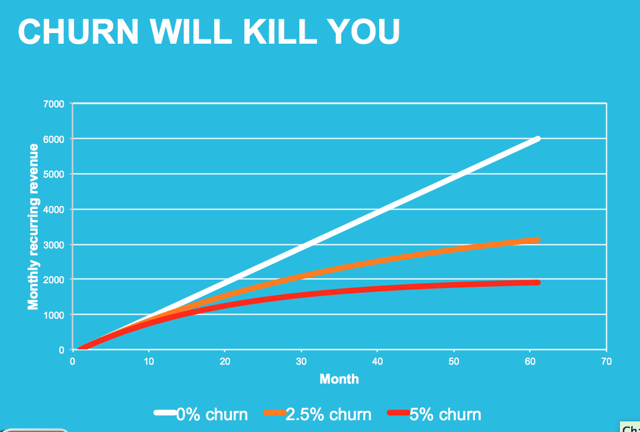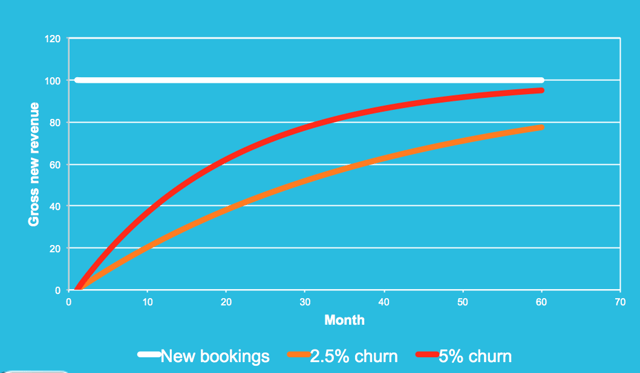This article is a prequel to my eBook, "Persuading Customer Support to Sell." In the book, I share how to get Support to contribute to sales in a non-salesy way. Why should they do this? Because it helps you fight churn, and churn is slowly but surely killing your business.
Customer Support doesn't bring in new sales prospects - they prevent churn. They're talking to customers after the purchase to ensure customers are happy. If they're not, then they work to quickly help or appease them so they're either happy again, or not mad enough to leave.
When a customer leaves you, this is churn. Churn is people falling out of love with your company. Churn is the biggest problem for the lifetime value of a customer.
Why worry about churn?
Preventing churn is just as important as, and maybe more important than, generating new sales. Here's why.
This is a simplified model that actually applies to any business that actually cares about getting customers to return:

This graph is over 60 months (five years). At the beginning the lines are basically the same.
In the beginning, every company is focused on sales to move these lines. Everyone focuses on sales and marketing (read: getting new leads) because in the beginning you don't even have churn to care about.
As we move into the future, the lines begin to diverge:
- The white line is the happy ideal universe where you’re adding customers every month on a nice consistent business. Zero percent churn. No one ever leaves you. They’re with you forever. It's like the Hotel California, it's great!
- The orange line is 2.5 percent churn, a pretty reasonable churn rate in the small- to mid-size business (SMB) SaaS space.
- The red line is 5 percent churn. Again, another reasonable number.
Now, as we move from left to right, approaching about the third year, some churn begins to show. Revenue starts to flatten and it gets harder and harder to grow.
Then by five years, growth is flat. It appears as though growth has stopped and employees start to panic. This is the point where businesses often say, “I really need to worry about churn!”
However, if you wait this long to address churn, you are throwing away your company:
- If you had no churn you’d be way up at the top of the white line;
- but if you have 2.5 percent churn your company is worth half;
- and if you have 5 percent churn your company is worth a third.
Wait five years and you've waited too long. Think about how much money and company value you've thrown away because you didn't care about churn. This is literally killing you. You worked all this time to build this company and at the end you’re going to end up dead anyway. This is a big problem.
Why does this happen?
As the number of customers you have continues to grow over time, the number of customers who churn will also grow. Even if you keep your churn rate stable, the number of customers churning is going to keep getting bigger and bigger until it matches the number of customers you're adding every month.
When your churned accounts equals your new accounts, you have hit your growth ceiling.

Eventually, you must work every month just to replace the customers leaving. That is as far as it's ever going to get. It's treading water. It's treading water, out in the sea, for the rest of your life. It’s horrible. You never want to get to this point.
How do I prevent churn?
I'm not going to pretend I have all the answers here. Preventing churn is challenging. If it were easy, we all would have retired to a tropical island a long time ago.
What makes it challenging? Customers, and their love affair with other brands. You might think it's exclusive, but it's an open relationship, and a customer can decide to leave you whenever they want. If you don't treat them right, they'll be on their way.
Here's one way to treat them right: don't have your Support team try to upsell them. This is a #classic mistake that Comcast famously made, which I talk more about in my book. Just because your Support team talks to customers every day, doesn't mean they should also be selling and trying to meet quotas. That results in a bad customer experience and, ultimately, churn.
If you want your Support team to sell, you have to treat them like a Support team but *think* about how they help or hurt sales. And then take action. There's a lot to say about that. In fact, we have dozens of techniques lined up in my ebook, all of which came from our customers actual practices.
Sunir's eBook "Persuading Customer Support to Sell" is available now:


